Hayder Al-Hraishawi
In-Lab Carrier Aggregation Testbed for Satellite Communication Systems
Aug 26, 2025Abstract:Carrier Aggregation (CA) is a technique used in 5G and previous cellular generations to temporarily increase the data rate of a specific user during peak demand periods or to reduce carrier congestion. CA is achieved by combining two or more carriers and providing a virtual, wider overall bandwidth to high-demand users of the system. CA was introduced in the 4G/LTE wireless era and has been proven effective in 5G as well, where it is said to play a significant role in efficient network capacity management. Given this success, the satellite communication (SatCom) community has put its attention into CA and the potential benefits it can bring in terms of better spectrum utilization and better meeting the user traffic demand. While the theoretical evaluation of CA for SatCom has already been presented in several works, this article presents the design and results obtained with an experimentation testbed based on Software Defined Radio (SDR) and a satellite channel emulator. We first present the detailed implementation design, which includes a Gateway (GW) module responsible for PDU-scheduling across the aggregated carriers, and a User Terminal (UT) module responsible for aggregating the multiple received streams. The second part of the article presents the experimental evaluation, including CA over a single Geostationary (GEO) satellite, CA over a single Medium Earth Orbit (MEO) satellite, and CA combining carriers sent over GEO and MEO satellites. A key contribution of this work is the explicit consideration of multi-orbit scenarios in the testbed design and validation. The testing results show promising benefits of CA over SatCom systems, motivating potential upcoming testing on over-the-air systems.
Pinching Antenna Systems versus Reconfigurable Intelligent Surfaces in mmWave
Jun 05, 2025Abstract:Flexible and intelligent antenna designs, such as pinching antenna systems and reconfigurable intelligent surfaces (RIS), have gained extensive research attention due to their potential to enhance the wireless channels. This letter, for the first time, presents a comparative study between the emerging pinching antenna systems and RIS in millimeter wave (mmWave) bands. Our results reveal that RIS requires an extremely large number of elements (in the order of $10^4$) to outperform pinching antenna systems in terms of spectral efficiency, which severely impact the energy efficiency performance of RIS. Moreover, pinching antenna systems demonstrate greater robustness against hardware impairments and severe path loss typically encountered in high-frequency mmWave bands.
Low-Complexity Channel Estimation Protocol for Non-Diagonal RIS-Assisted Communications
Apr 28, 2025Abstract:Non-diagonal reconfigurable intelligent surfaces (RIS) offer enhanced wireless signal manipulation over conventional RIS by enabling the incident signal on any of its $M$ elements to be reflected from another element via an $M \times M$ switch array. To fully exploit this flexible configuration, the acquisition of individual channel state information (CSI) is essential. However, due to the passive nature of the RIS, cascaded channel estimation is performed, as the RIS itself lacks signal processing capabilities. This entails estimating the CSI for all $M \times M$ switch array permutations, resulting in a total of $M!$ possible configurations, to identify the optimal one that maximizes the channel gain. This process leads to long uplink training intervals, which degrade spectral efficiency and increase uplink energy consumption. In this paper, we propose a low-complexity channel estimation protocol that substantially reduces the need for exhaustive $M!$ permutations by utilizing only three configurations to optimize the non-diagonal RIS switch array and beamforming for single-input single-output (SISO) and multiple-input single-output (MISO) systems. Specifically, our three-stage pilot-based protocol estimates scaled versions of the user-RIS and RIS-base-station (BS) channels in the first two stages using the least square (LS) estimator and the commonly used ON/OFF protocol from conventional RIS. In the third stage, the cascaded user-RIS-BS channels are estimated to enable efficient beamforming optimization. Complexity analysis shows that our proposed protocol significantly reduces the BS computational load from $\mathcal{O}(NM\times M!)$ to $\mathcal{O}(NM)$, where $N$ is the number of BS antennas. This complexity is similar to the conventional ON/OFF-based LS estimation for conventional diagonal RIS.
Beyond Diagonal RIS-Aided Networks: Performance Analysis and Sectorization Tradeoff
Jun 06, 2024Abstract:Reconfigurable intelligent surfaces (RISs) have emerged as a spectrum- and energy-efficient technology to enhance the coverage of wireless communications within the upcoming 6G networks. Recently, novel extensions of this technology, referred to as multi-sector beyond diagonal RIS (BD-RIS), have been proposed, where the configurable elements are divided into $L$ sectors $(L \geq 2)$ and arranged as a polygon prism, with each sector covering $1/L$ space. This paper presents a performance analysis of a multi-user communication system assisted by a multi-sector BD-RIS operating in time-switching (TS) mode. Specifically, we derive closed-form expressions for the moment-generating function (MGF), probability density function (PDF), and cumulative density function (CDF) of the signal-to-noise ratio (SNR) per user. Furthermore, closed-form expressions for the outage probability, achievable spectral and energy efficiency, symbol error probability, and diversity order for the proposed system model are derived. Moreover, a comparison is performed with the simultaneously transmitting and reflecting (STAR)-RISs, a special case of multi-sector BD-RIS with two sectors. Our analysis shows that for a fixed number of elements, increasing the sectors improves outage performance at the expense of reduced diversity order compared to STAR-RIS. This trade-off is influenced by the Rician factors of the cascaded channel and the number of configurable elements per sector. However, this superiority in slope is observed at outage probability values below $10^{-5}$, which remains below practical operating ranges of communication systems. Additionally, simulations are provided to validate the accuracy of our theoretical analyses showing a notable $182\%$ increase in spectral efficiency and a $238\%$ increase in energy efficiency when transitioning from a 2-sector to a 6-sector configuration.
Digital Twin for Non-Terrestrial Networks: Vision, Challenges, and Enabling Technologies
May 17, 2023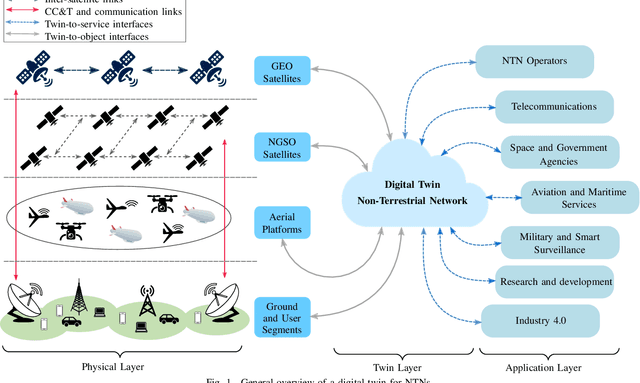
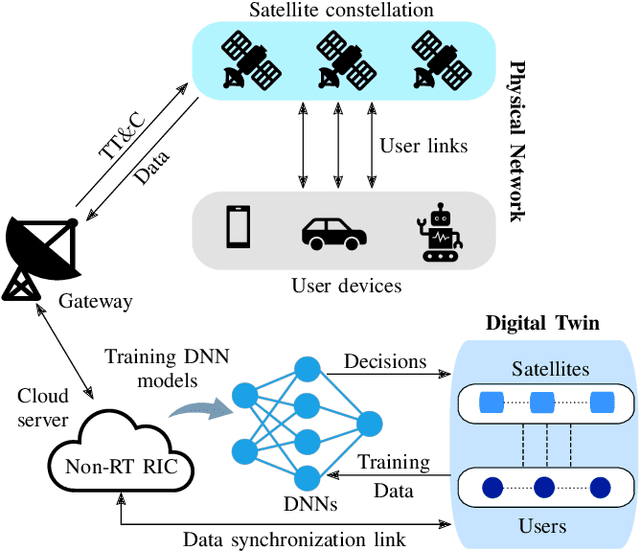
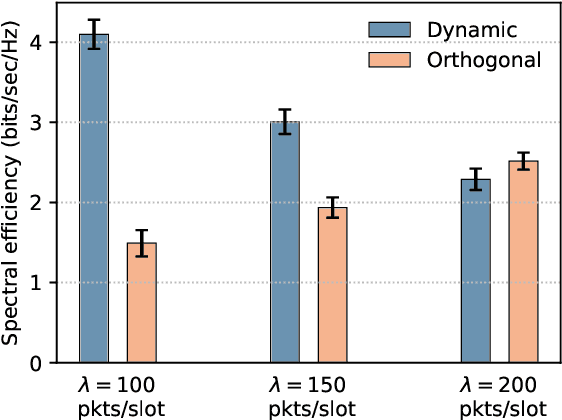
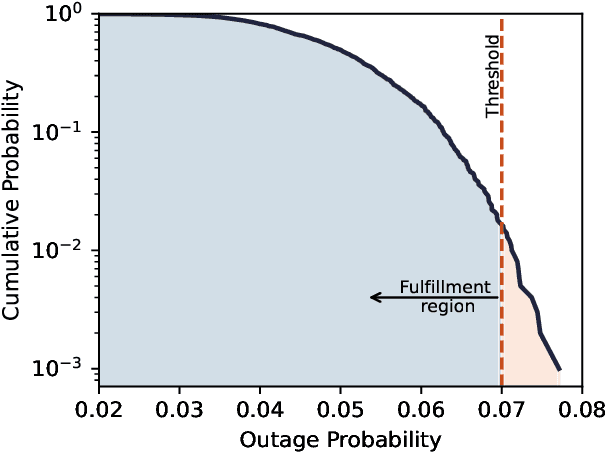
Abstract:The ongoing digital transformation has sparked the emergence of various new network applications that demand cutting-edge technologies to enhance their efficiency and functionality. One of the promising technologies in this direction is the digital twin, which is a new approach to design and manage complicated cyber-physical systems with a high degree of automation, intelligence, and resilience. This article discusses the use of digital twin technology as a new approach for modeling non-terrestrial networks (NTNs). Digital twin technology can create accurate data-driven NTN models that operate in real-time, allowing for rapid testing and deployment of new NTN technologies and services, besides facilitating innovation and cost reduction. Specifically, we provide a vision on integrating the digital twin into NTNs and explore the primary deployment challenges, as well as the key potential enabling technologies within NTN realm. In closing, we present a case study that employs a data-driven digital twin model for dynamic and service-oriented network slicing within an open radio access network (O-RAN) NTN architecture.
An Overview of Channel Models for NGSO Satellites
Sep 21, 2022
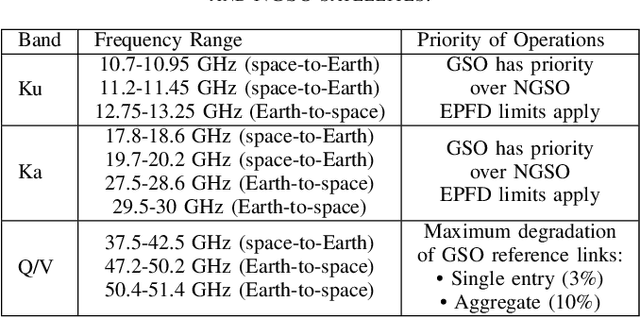
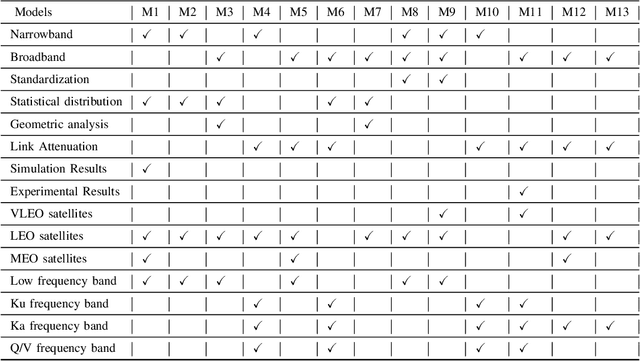
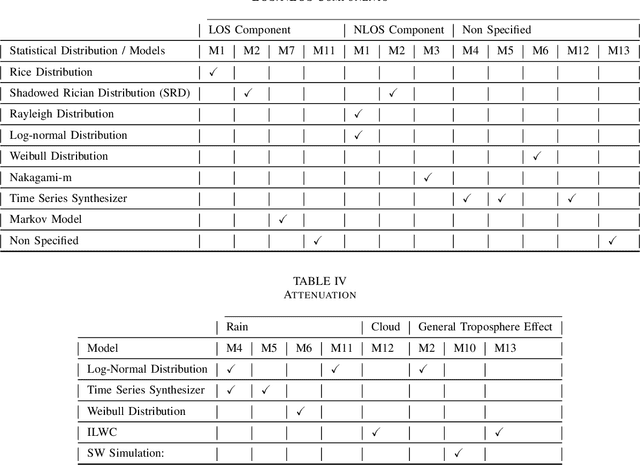
Abstract:Satellite communications industry is currently going through a rapid and profound transformation to adapt to the recent innovations and developments in the realm of non-geostationary orbit (NGSO) satellites. The growing popularity of NGSO systems, with cheap manufacturing and launching costs, has set to revolutionize the internet market. In this context, accurate channel characterization is crucial for the performance optimization and designing efficient NGSO communications, especially considering the dynamic propagation environment. While the Third Generation Partnership Project (3GPP) has provided some guidelines in Release 15, we observed certain divergence on the channel models considered in the literature, each with different assumptions and peculiarities. This paper provides an extensive review of the existing methods proposed for NGSO channel modeling that consider different orbits, frequency bands, user equipment, use-case and scenario peculiarities. The provided review discusses the channel modeling efforts from a contemporary perspective through trade-off analyses, classifications, and highlighting their advantages and pitfalls. The main goal is to provide a comprehensive overview of NGSO channel models to facilitate the selection of the most appropriate channel based on the scenario requirements to be evaluated and/or analysed.
Joint Beam Hopping and Carrier Aggregation in High Throughput Multi-Beam Satellite Systems
Jun 24, 2022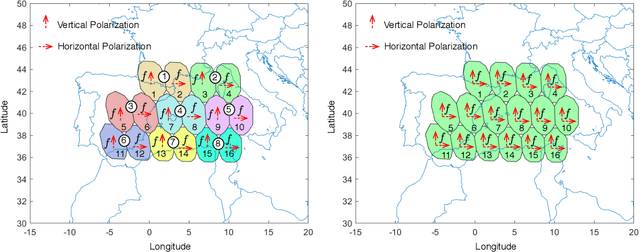
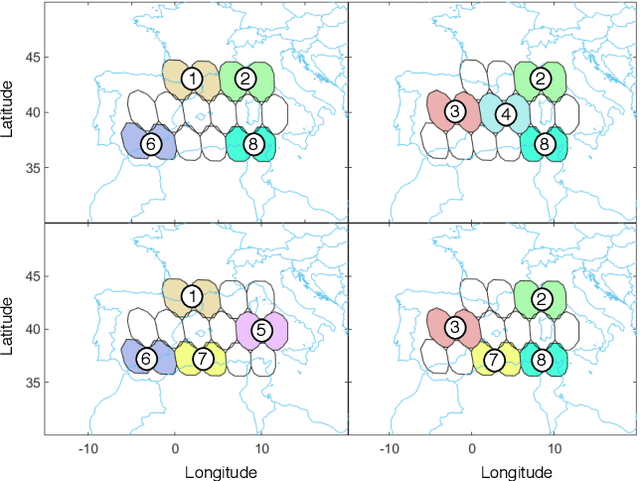
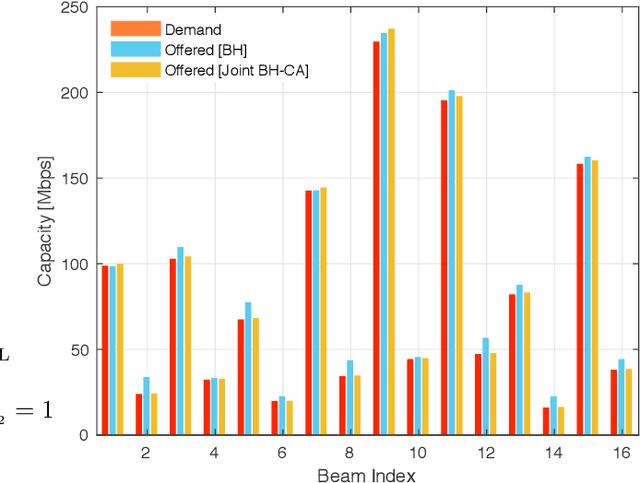

Abstract:Beam hopping (BH) and carrier aggregation (CA) are two promising technologies for the next generation satellite communication systems to achieve several orders of magnitude increase in system capacity and to significantly improve the spectral efficiency. While BH allows a great flexibility in adapting the offered capacity to the heterogeneous demand, CA further enhances the user quality-of-service (QoS) by allowing it to pool resources from multiple adjacent beams. In this paper, we consider a multi-beam high throughput satellite (HTS) system that employs BH in conjunction with CA to capitalize on the mutual interplay between both techniques. Particularly, an innovative joint BH-CA scheme is proposed and analyzed in this work to utilize their individual competencies. This includes designing an efficient joint time-space beam illumination pattern for BH and multi-user aggregation strategy for CA. Through this, user-carrier assignment, transponder filling-rates, beams hopping pattern, and illumination duration are all simultaneously optimized by formulating a joint optimization problem as a multi-objective mixed integer linear programming problem (MINLP). Simulation results are provided to corroborate our analysis, demonstrate the design tradeoffs, and point out the potentials of the proposed joint BH-CA concept. Advantages of our BH-CA scheme versus the conventional BH method without employing CA are investigated and presented under the same system circumstances.
Improved Gaussian-Bernoulli Restricted Boltzmann Machines for UAV-Ground Communication Systems
Jun 16, 2022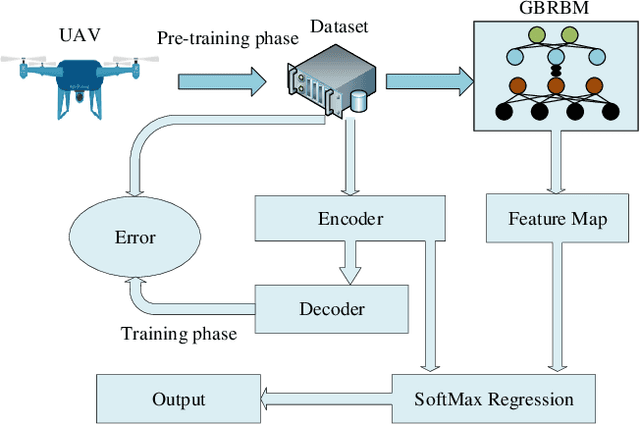

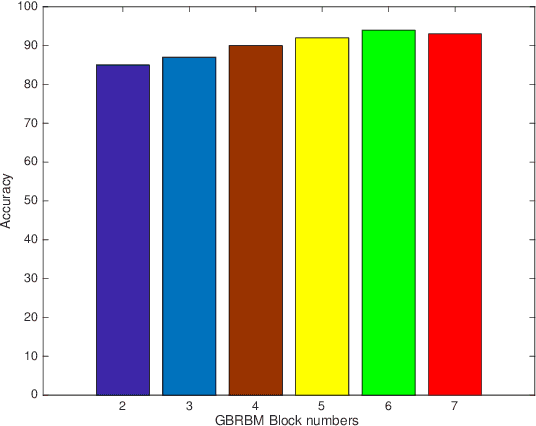
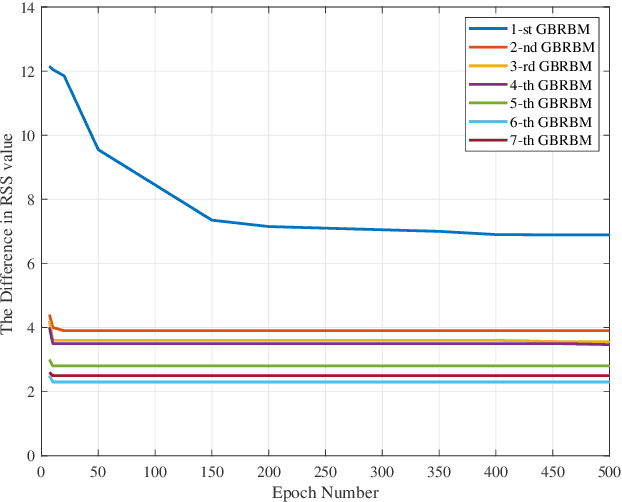
Abstract:Unmanned aerial vehicle (UAV) is steadily growing as a promising technology for next-generation communication systems due to their appealing features such as wide coverage with high altitude, on-demand low-cost deployment, and fast responses. UAV communications are fundamentally different from the conventional terrestrial and satellite communications owing to the high mobility and the unique channel characteristics of air-ground links. However, obtaining effective channel state information (CSI) is challenging because of the dynamic propagation environment and variable transmission delay. In this paper, a deep learning (DL)-based CSI prediction framework is proposed to address channel aging problem by extracting the most discriminative features from the UAV wireless signals. Specifically, we develop a procedure of multiple Gaussian Bernoulli restricted Boltzmann machines (GBRBM) for dimension reduction and pre-training utilization incorporated with an autoencoder-based deep neural networks (DNNs). To evaluate the proposed approach, real data measurements from an UAV communicating with base-stations within a commercial cellular network are obtained and used for training and validation. Numerical results demonstrate that the proposed method is accurate in channel acquisition for various UAV flying scenarios and outperforms the conventional DNNs.
Deep Learning-Based Device-Free Localization in Wireless Sensor Networks
Jun 16, 2022

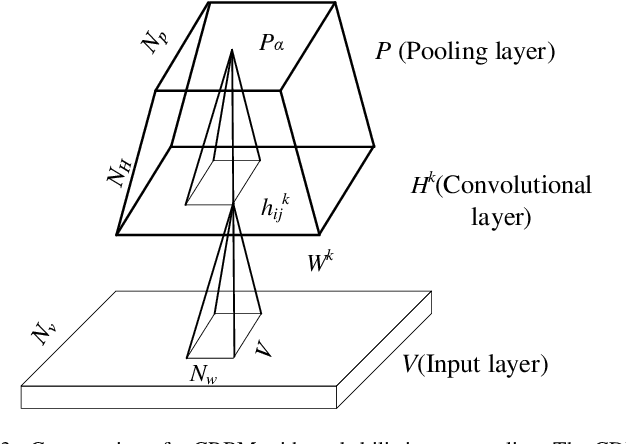

Abstract:Location-based services (LBS) are witnessing a rise in popularity owing to their key features of delivering powerful and personalized digital experiences. The recent developments in wireless sensing techniques make the realization of device-free localization (DFL) feasible in wireless sensor networks. The DFL is an emerging technology that utilizes radio signal information for detecting and positioning a passive target while the target is not equipped with a wireless device. However, determining the characteristics of the massive raw signals and extracting meaningful discriminative features relevant to the localization are highly intricate tasks. Thus, deep learning (DL) techniques can be utilized to address the DFL problem due to their unprecedented performance gains in many practical problems. In this direction, we propose a DFL framework consists of multiple convolutional neural network (CNN) layers along with autoencoders based on the restricted Boltzmann machines (RBM) to construct a convolutional deep belief network (CDBN) for features recognition and extracting. Each layer has stochastic pooling to sample down the feature map and reduced the dimensions of the required data for precise localization. The proposed framework is validated using real experimental dataset. The results show that our algorithm can achieve a high accuracy of 98% with reduced data dimensions and low signal-to-noise ratios (SNRs).
Multi-layer Space Information Networks: Access Design and Softwarization
Oct 15, 2021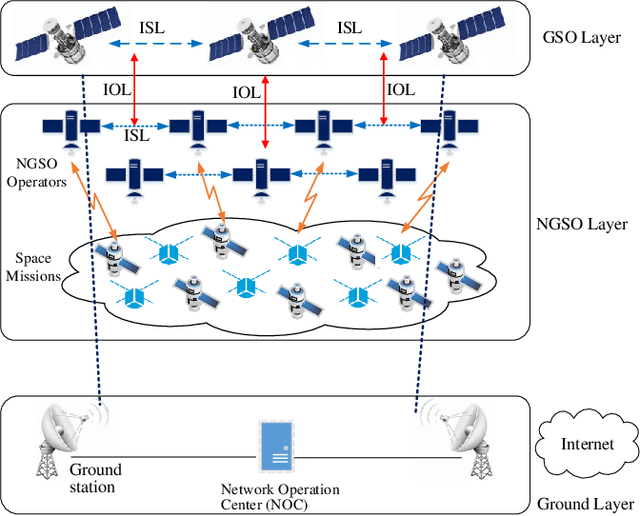
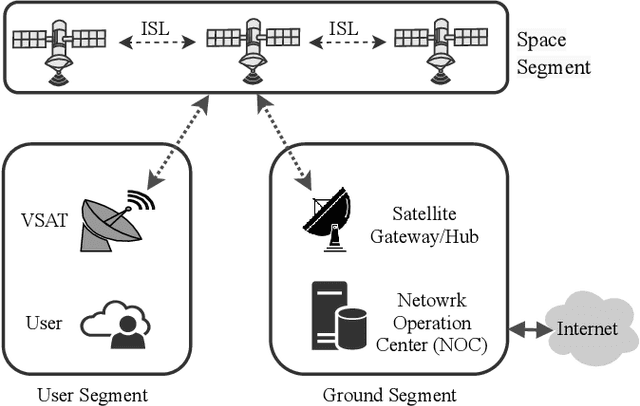
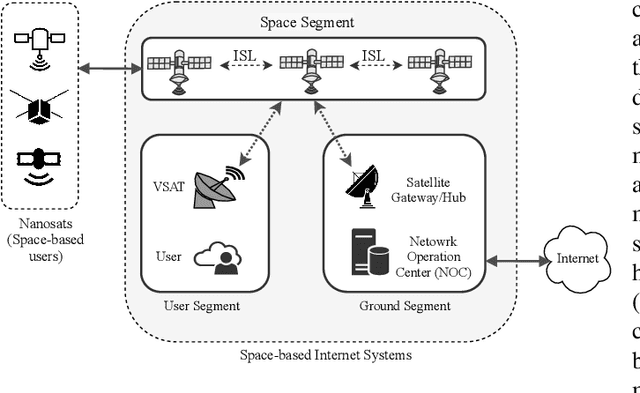
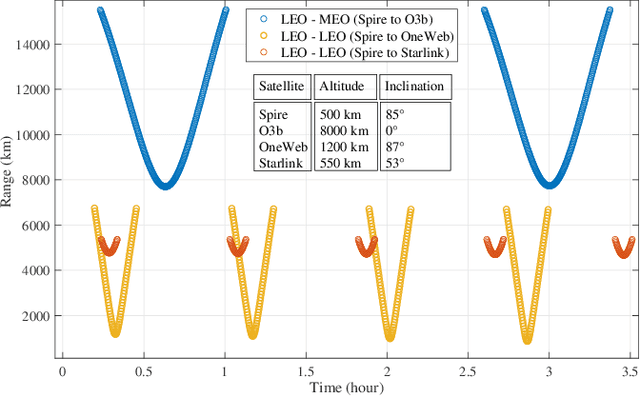
Abstract:In this paper, we propose an approach for constructing a multi-layer multi-orbit space information network (SIN) to provide high-speed continuous broadband connectivity for space missions (nanosatellite terminals) from the emerging space-based Internet providers. This notion has been motivated by the rapid developments in satellite technologies in terms of satellite miniaturization and reusable rocket launch, as well as the increased number of nanosatellite constellations in lower orbits for space downstream applications, such as earth observation, remote sensing, and Internet of Things (IoT) data collection. Specifically, space-based Internet providers, such as Starlink, OneWeb, and SES O3b, can be utilized for broadband connectivity directly to/from the nanosatellites, which allows a larger degree of connectivity in space network topologies. Besides, this kind of establishment is more economically efficient and eliminates the need for an excessive number of ground stations while achieving real-time and reliable space communications. This objective necessitates developing suitable radio access schemes and efficient scalable space backhauling using inter-satellite links (ISLs) and inter-orbit links (IOLs). Particularly, service-oriented radio access methods in addition to software-defined networking (SDN)-based architecture employing optimal routing mechanisms over multiple ISLs and IOLs are the most essential enablers for this novel concept. Thus, developing this symbiotic interaction between versatile satellite nodes across different orbits will lead to a breakthrough in the way that future downstream space missions and satellite networks are designed and operated.
 Add to Chrome
Add to Chrome Add to Firefox
Add to Firefox Add to Edge
Add to Edge